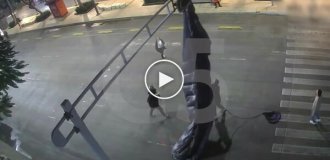Construction of the Ostankino Tower (11 photos + text)
Today, based on materials from the website “Photographs of Old Moscow” and the magazine “Science and Life”, I will tell you how the Ostankino Tower was built.

The tower, which weighs more than 32 thousand tons, was erected on a monolithic circular reinforced concrete foundation with a width of 9.5 meters, a height of 3 meters and a diameter (circumscribed circle) of 74 meters. In the decagonal reinforced concrete strip of the foundation, using a system of ring-stressed reinforcement (it consists of 104 bundles, each bundle has 24 wires with a diameter of 5 millimeters each), a preliminary stress is created - each bundle is tensioned with hydraulic jacks with a force of about 60 tons.

The foundation is laid in the ground to a depth of 4.65 meters. It is expected that it will settle by 3-3.5 centimeters. The tower's stability against overturning has a six-fold margin.

The reinforced concrete support of the entire structure is a thin-walled conical shell supported by ten reinforced concrete “legs” on the foundation benches. The diameter of the lower base of this shell is 60.6 meters, and at a height of 63 meters it is 18 meters. The upper part of the reinforced concrete shaft, starting from a height of 321 meters, is made in the form of a cylinder with an outer diameter of 8.1 meters. The thickness of the walls at the base of the tower is 500 millimeters.

In the center of the conical base, on a separate foundation (a round reinforced concrete slab with a diameter of 12 meters and a thickness of 1 meter), a reinforced concrete glass with a height of 63 meters and a diameter of 7.5 meters was erected. This glass contains high-speed elevators, power cables, communication cables, a shaft with water supply and sewer risers and an emergency steel staircase. The ends of the beams of fifteen interfloor ceilings rest on the glass, and a staircase runs between the glass and the conical base. The construction of separate foundations for two independent structures - the tower and the glass - allows different pressures to be transferred to the ground when their settlement is uneven.

Under the influence of wind load, the upper part of the tower can oscillate, and the deflection of its top in strong winds can reach 10 meters. With winds that occur in Moscow quite often, on average once a week, visitors to observation decks and restaurants will feel the vibrations of the tower in approximately the same way as the rocking of a ship with an amplitude of 8 centimeters with a period of vibration of 10 seconds.
There is another “enemy” at the tower. This is the Sun. Due to one-sided heating, the trunk moves (from curvature) at the top by 2.25 meters, at the level of the observation platforms - by 0.72 meters. To reduce deformations from wind loads and from one-sided heating, 150 steel cables were stretched at a distance of 50 millimeters from the inner surface of the barrel. Their total tension force is 10,400 tons—this is the weight of an ocean-going steamer. The cables will take on tensile forces and protect the concrete from cracks, and, consequently, the reinforcement from corrosion.

Several metal antennas with a total height of 148 meters are installed on the reinforced concrete part of the tower. The antennas are made in the form of steel pipes. There are rigid diaphragms inside the pipes. A special elevator is used to service antennas up to a height of 470 meters. To inspect and dismantle vibrators, as well as periodically paint the steel structures of the antennas, 6 platforms with railings are installed and cradles are suspended.

During the construction of the tower, the latest achievements of construction technology were widely used. A unique tower crane BK-1000 with a lifting capacity of 16 tons (with a boom reach of 45 meters) assembled and installed metal structures. The tower trunk was constructed using the world's only self-elevating unit weighing about 300 tons. Concrete was delivered to this unit by elevators.

At a separate site, sections of metal antennas were assembled using a SKG-100 crawler crane (with a lifting capacity of 100 tons). This was a control assembly. At the same time, equipment was mounted on the antennas and vibrators were installed. Then the antenna sections were disassembled again, and their individual parts - drawers - were transported by crane to the loading area at a height of 63 meters. Then, using a special crane installed on the tower trunk, the first drawers were lifted to the top of the tower and mounted so that they went 10 meters inside its trunk. And after that the installation was carried out using a crawling crane.
The design of the architectural and construction part of the television tower was developed by the Central Scientific Research Institute of Experimental Buildings and Sports Facilities. Team of authors: design engineer N. Nikitin, architects D. Burdin, L. Batalov, V. Milashevsky, design engineer B. Zlobin, plumbing engineer T. Melik-Arakelyan. Separate parts of the project were developed by Mosproekt-1 and 19 other design organizations. The general design organization is GSPI of the USSR Ministry of Communications. The technological part of the project is carried out by a team of authors under the leadership of engineer I. Ostrovsky.

ANTENNA INSTALLATION DIAGRAM

After control assembly and adjustment of the antennas on the stand, individual mounting elements (tsents) weighing up to 25 tons are transferred by a crawler crane to the operating area of the ring crane. He lifts the drawer to the loading platform at a height of 63 m. An overhead crane, located at a height of 385 m, lifts the drawers to another transfer site located at a height of 370 meters. Then the self-lifting crane, moving along the mounted drawers, installs the newly arriving drawers on top of each other.

The last, topmost link is lifted by the crane from its middle. To maintain the vertical position of the link, its lower end is artificially weighted.
From a height of 385 m, the ring tracks of ground cranes are visible. In the foreground of the photo you can see a tarpaulin “skirt” with a rope frame. Behind it there are suspended scaffoldings, from which work is carried out to secure the outer formwork and inspect the outer surface of the concrete.
--
From the magazine "Science and Life" for 1966.





















